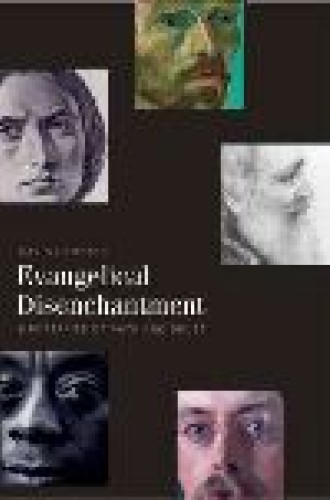Evangelical Disenchantment: Nine Portraits of Faith and Doubt
It takes a certain level of self-deception to be a lukewarm evangelical. Intense piety is in the tradition’s DNA. The need for not only a conversion experience but a life in which the gospel is internalized and alive and demonstrated in the world has given evangelicalism an impressive vitality. Every movement has its zealots, but evangelicalism democratizes zeal. Who needs monks when every believer is a Martin Luther?
Unsurprisingly, a tradition steeped in intense conversion stories has also bred its fair share of the opposite: what Harvard professor David Hempton calls disenchantment narratives. Hempton’s aim is straightforward: “This book is about a collection of energetic and talented historical figures who once had close encounters with various species of evangelical Christianity, but who did not remain in that tradition.” The nine figures he highlights are prominent indeed: novelist George Eliot, missionary-turned-provocateur Francis Newman, jack-of-all-reforms Theodore Dwight Weld, a trio of early feminists (Sarah Grimké, Elizabeth Cady Stanton and Frances Willard), artist Vincent van Gogh and writers Edmund Gosse and James Baldwin.
It’s an impressive and unlikely mix, and this eclecticism is part of the book’s appeal. The subjects span Europe and America, the 19th and 20th centuries, and the historical divides of gender and race. The scholarly Eliot translated Feuerbach and Spinoza and wrote the great novel Middlemarch; Newman, younger brother of the famous cardinal John Henry Newman, traveled as a missionary to Baghdad and came back questioning the doctrine of the Trinity; van Gogh was a model of self-denial when he served among Belgian miners but was told by superiors to try a different vocation (he did); Grimké was the daughter of wealthy slaveholding Episcopalians; Gosse, the child of strict Plymouth Brethren, wrote the definitive memoir of an evangelical childhood, Father and Son; and the precocious Baldwin was a teenage preacher in Harlem before becoming the author of Go Tell It on the Mountain.
Hempton’s subjects are too exceptional for an easy thesis about evangelicalism, but their trajectories overlap in fascinating ways. Except perhaps for Gosse, these artists and reformers don’t seem to have fled from evangelicalism as fugitives so much as they spilled over its edges and into new channels. The same intensity that led them into evangelicalism pressed them to seek greater vitality than the orthodoxy of their tradition could contain. They are in their strange ways tributes to evangelical zeal even though they made very probing critiques of the tradition they left behind. With all those Martin Luthers, you can expect some private Reformations.
The most damning critique of evangelicalism in the book is the charge that its portrait of God is morally problematic, that evangelicals portray God as dictatorial, arbitrary, harsh. For some 19th-century figures nourished in the evangelical tradition (particularly its Calvinist strain), the standards of morality to which reformers were holding society seemed higher than the ethics of orthodox Christianity. God seemed to do things that were cruel and unusual.
Gosse was struck, in particular, by the contradiction between his own father’s gentleness and the character of the God his father believed in: “He who was so tender-hearted that he could not witness the pain or distress of any person, however disagreeable or undeserving, was quite acquiescent in believing that God would punish human beings, in millions, for ever, for a purely intellectual error of comprehension.” George Eliot revolted against the “grim moral implications” of the sermons of a prominent London preacher. In a work Hempton calls a diatribe, Francis Newman singled out original sin, vicarious atonement and eternal punishment as particularly objectionable, and he went farther than Eliot by spreading the blame to Jesus: “In consistency of goodness Jesus fell far below vast numbers of his unhonoured disciples.”
None of this is new ground—nor, as recent books by so-called neo-atheists attest, is it exhausted ground—but since the default narrative about religion in the modern world is that science put the panic in orthodox ranks, it is instructive to refocus on moral sensibility. Hempton explicitly sets the debate with science to one side and examines the uneasy relationship, for some, between traditional evangelicalism and modern moral ideals: “Among some thoughtful evangelicals, moral repudiation of biblical ethics preceded, and was often more important than, difficulties presented by biblical criticism and Darwinian evolution. These intellectual challenges did not so much cause doubt and infidelity as they did inform, rationalize, and justify both.”
In Toni Morrison’s recent novel A Mercy, one of the characters (who has lost all her children to disease or accident) vents a critique of God that would have resonated with Eliot, Newman, Gosse and other disaffected evangelicals of their times: “I don’t think God knows who we are. I think He would like us, if He knew us, but I don’t think He knows about us. . . . He’s doing something else in the world. We are not on His mind.”
Other common strands of these narratives flow from this shifting moral sense. Van Gogh (more steeped in religion than this lover of his paintings realized) moved on from evangelicalism because it seemed too narrow to accommodate his artistic sense. Hempton comments: “The Bible was not redundant” for van Gogh; “it was simply not enough.” The social idealism of Weld and Stanton outran their orthodoxy. Bald win, combining the moral critique of the Victorians with the dashed utopianism of Weld, wondered, “If His love was so great, and if He loved all His children, why were we, the blacks, cast down so far?”
In all these portraits there is a sense that a tradition whose strength has been intensity of belief may have nourished in some prominent adherents an idealism the tradition itself could not sustain. Hempton’s minibiographies show that certain kinds of vitality, particularly the ones that shade toward the arts, prove hard for the evangelical tradition to manage or accommodate. This is not the whole story—and Hempton doesn’t suggest that it is—but the dilemmas these figures faced are alive and well because the tradition they broke with is still thriving.






